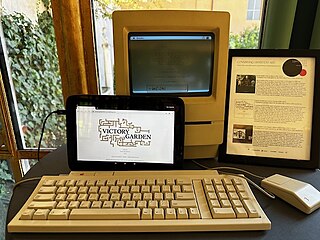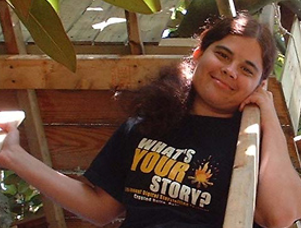Related Research Articles

Hypertext is text displayed on a computer display or other electronic devices with references (hyperlinks) to other text that the reader can immediately access. Hypertext documents are interconnected by hyperlinks, which are typically activated by a mouse click, keypress set, or screen touch. Apart from text, the term "hypertext" is also sometimes used to describe tables, images, and other presentational content formats with integrated hyperlinks. Hypertext is one of the key underlying concepts of the World Wide Web, where Web pages are often written in the Hypertext Markup Language (HTML). As implemented on the Web, hypertext enables the easy-to-use publication of information over the Internet.
Hypertext fiction is a genre of electronic literature, characterized by the use of hypertext links that provide a new context for non-linearity in literature and reader interaction. The reader typically chooses links to move from one node of text to the next, and in this fashion arranges a story from a deeper pool of potential stories. Its spirit can also be seen in interactive fiction.

Shelley Jackson is an American writer and artist known for her cross-genre experimental works. These include her hyperfiction Patchwork Girl (1995) and her first novel, Half Life (2006).
Michael Joyce is a retired professor of English at Vassar College, New York, US. He is also an important author and critic of electronic literature.
Electronic literature or digital literature is a genre of literature where digital capabilities such as interactivity, multimodality or algorithmic text generation are used aesthetically. Works of electronic literature are usually intended to be read on digital devices, such as computers, tablets, and mobile phones. They cannot be easily printed, or cannot be printed at all, because elements crucial to the work cannot be carried over onto a printed version.

afternoon, a story, spelled with a lowercase 'a', is a work of electronic literature written in 1987 by American author Michael Joyce. It was published by Eastgate Systems in 1990 and is known as one of the first works of hypertext fiction.
George Paul Landow was Professor of English and Art History Emeritus at Brown University. He was a leading authority on Victorian literature, art, and culture, as well as a pioneer in criticism and theory of Electronic literature, hypertext and hypermedia. He also pioneered the use of hypertext and the web in higher education.

Patchwork Girl or a Modern Monster by Mary/Shelly and Herself is a work of electronic literature by American author Shelley Jackson. It was written in Storyspace and published by Eastgate Systems in 1995. It is often discussed along with Michael Joyce's afternoon, a story as an important work of hypertext fiction.

Victory Garden is a work of electronic literature by American author Stuart Moulthrop. It was written in StorySpace and first published by Eastgate Systems in 1991. Victory Garden is one of the earliest examples of hypertext novels, and is notable for being very inventive and influential in its genre. It is often discussed along with Michael Joyce's afternoon, a story as an important work of hypertext fiction.
Jay David Bolter is the Wesley Chair of New Media and a professor in the School of Literature, Media, and Communication at the Georgia Institute of Technology. His areas of study include the evolution of media, the use of technology in education, and the role of computers in the writing process. More recently, he has conducted research in the area of augmented reality and mixed media. Bolter collaborates with researchers in the Augmented Environments Lab, co-directed with Blair MacIntyre, to create apps for entertainment, cultural heritage and education for smart phones and tablets. This supports his theory regarding remediation where he discusses "all media functions as remediators and that remediation offers us a means of interpreting the work of earlier media as well".
Stuart Moulthrop is an innovator of electronic literature and hypertext fiction, both as a theoretician and as a writer. He is author of the hypertext fiction works Victory Garden (1992), which was on the front-page of the New York Times Book Review in 1993, Reagan Library (1999), and Hegirascope (1995), amongst many others. Moulthrop is currently a Professor of Digital Humanities in the Department of English, at the University of Wisconsin–Milwaukee. He also became a founding board member of the Electronic Literature Organization in 1999.
Tinderbox is a personal content management system and personal knowledge base.
Judy Malloy is an American poet whose works embrace the intersection of hypernarrative, magic realism, and information art. Beginning with Uncle Roger in 1986, Malloy has composed works in both new media literature and hypertext fiction. She was an early creator of online interactive and collaborative fiction on The WELL and the website ArtsWire.
Storyspace is a software program for creating, editing, and reading hypertext fiction. It can also be used for writing and organizing fiction and non-fiction intended for print. Maintained and distributed by Eastgate Systems, the software is available both for Windows and Mac.

Deena Larsen is an American new media and hypertext fiction author involved in the creative electronic writing community since the 1980s. Her work has been published in online journals such as the Iowa Review Web, Cauldron and Net, frAme, inFLECT, and Blue Moon Review. Since May 2007, the Deena Larsen Collection of early electronic literature has been housed at the Maryland Institute for Technology in the Humanities.
King of Space is a work of electronic literature by author Sarah Smith and Mark Bernstein, originally published in 1991. This interactive narrative is set in a collapsing solar system aboard an abandoned starship, where an escaped terrorist encounters the last star-captain and his ship's Priestess. The story weaves elements of gaming into a dark science-fictional ritual of fertility and regeneration.
Its Name Was Penelope is a hypertext fictional story created by Judy Malloy and published in 1993 by Eastgate Systems. The work makes use of digital elements such as randomized passages to tell the story of the main character's life.

Uncle Buddy's Phantom Funhouse is an early multimedia hypermedia text written by John McDaid and released by Eastgate Systems in 1993. The main portion of Funhouse was written for Macintosh's HyperCard app, but portions of the hypermedia novel are also contained on physical tapes, playing cards, and pieces of paper. The use of transmedia storytelling, meta-fiction, and epistolary format makes this a potential early example of an alternate reality game.
The NEXT: Museum, Library, and Preservation Space is a repository of net art, electronic literature and games. It is supported by the Electronic Literature Lab, Washington State University at Vancouver and the Electronic Literature Organization. This is a digital museum dedicated to reviving and maintaining these works to make them accessible to all. Physical artifacts are held at the Electronic Literature Lab in Washington, US.
References
- Miller, Laura (March 15, 1998). "Bookend; www.claptrap.com". The New York Times. Retrieved on August 13, 2007.
- Guernsey, Lisa (April 15, 1999). "New York Times: New Kind of Convergence: Writers and Programmers". The New York Times. Retrieved on August 13, 2007.